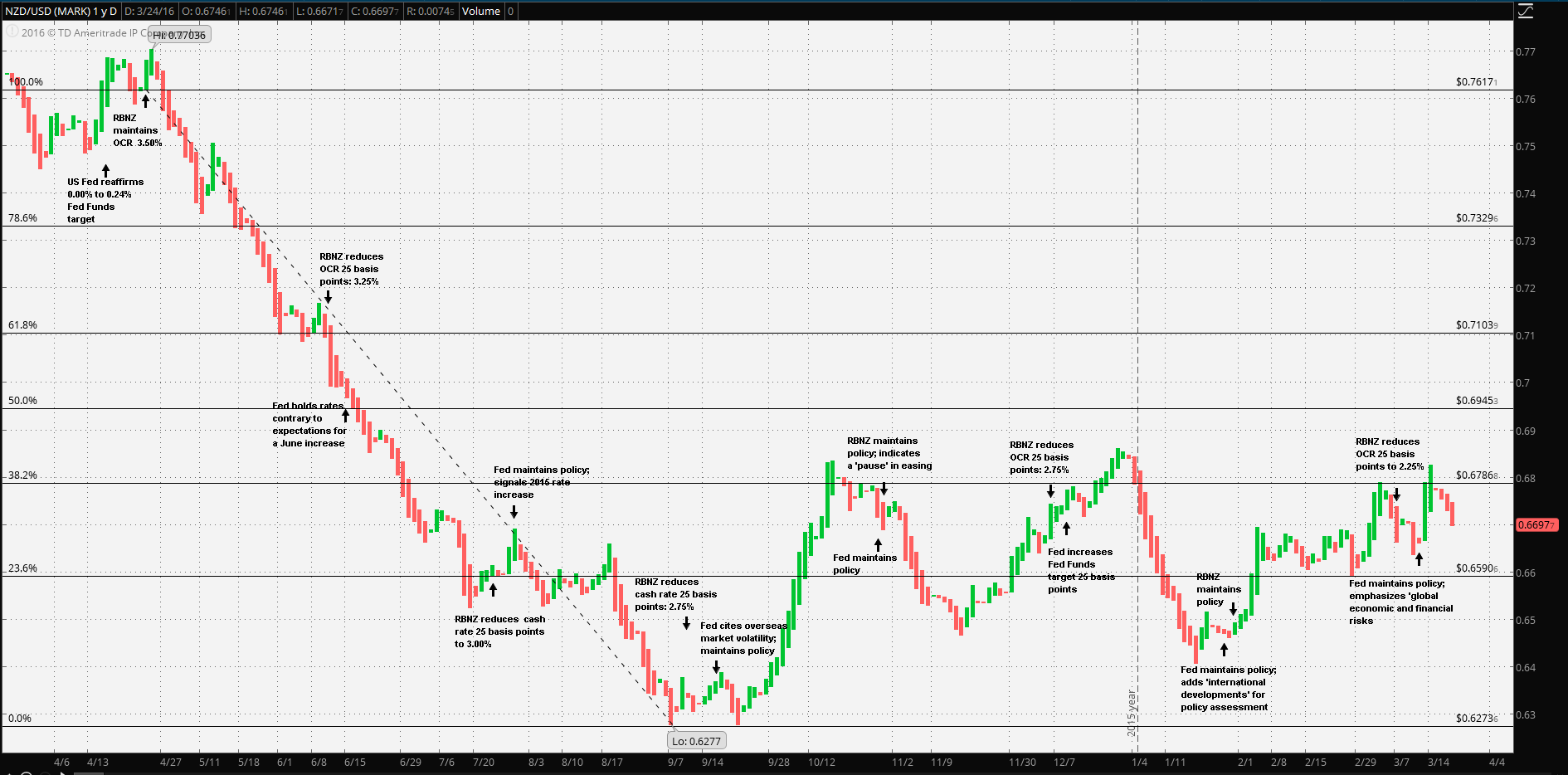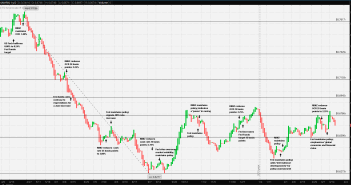USD/NZD is among the top traded FX currency pairs and it shouldn’t be surprising. The Kiwi currently carries a 175 to 200 basis point spread over the US Dollar. As far as trade, the US is New Zealand’s third largest trade partner. The US exports a wide variety of industrial products, automobiles, aircraft parts, medical instruments and pharmaceuticals being among the top products. Conversely, the US imports, in large part, agricultural products, which naturally includes dairy products. Hence there’s an incentive to maintain stability of the pair. This is far easier said than done especially when dealing with the massive US economy. As if this isn’t enough, the Reserve Bank of New Zealand must also contend with three other global economic heavyweights which are first, second and fourth in trade partnership, respectively: China, Australia and Japan.
From the RBNZ point of view, the BOJ and RBA must be highly predictable when compared to the PBOC and the Fed. As it is now, a weaker Kiwi relative to the US would outweigh the increased cost of imports from the US. The weaker Kiwi has been a benefit for the tourism and hospitality sector, for one example. It might have also indirectly dampened New Zealand’s increasing housing price growth.
Guest post by Mike Scrive of Accendo Markets
In April of 2015, the benchmark rate spread between the Fed and RBNZ was a hefty 350 to 325 basis points. The RBNZ maintained policy OCR 3.50% at the 30 April meeting, specifically referring to trade in the opening lines: “…Trading partner growth continues at around its long-term average, but remains dependent on highly accommodative monetary settings…”
Again, although markets were pricing in a June 2015 Fed Funds increase, the signals attributed to the Fed, via speeches and interviews of various Fed board members were increasingly confusing. This did not go unnoticed by the RBNZ. “…considerable uncertainties exist in Europe, China and Australia, and on the timing of US monetary policy adjustment…” A 25 basis point Fed increase plus a 25 basis point RBNZ rate cut would reduce the spread by 25 to 50 basis points, hopefully weakening the Kiwi.
As time passed, US economic data proved encouraging but unremarkable. The RBNZ reduced 25 basis points on 11 June citing “…Data on economic activity in the US, China and Australia has been mixed, although there has been some improvement in the euro area and Japan. Volatility in financial markets has increased…”
Indeed, the Fed couldn’t justify a June increase, “…To support continued progress toward maximum employment and price stability, the Committee today reaffirmed its view that the current 0 to 1/4 percent target range for the federal funds rate remains appropriate…” The Fed also included the phrase “… readings on financial and international developments…” in its decision to maintain rates. Hence, the Fed decided to maintain rates, in part, for the same reasons the RBNZ wanted to reduce rates.

The RBNZ didn’t let any grass grow under its feet over the next three meetings, taking the OCR down 25 basis points at each to 2.75%. Interestingly, in the July statement the RBNZ noted “…New Zealand’s economy is currently growing at an annual rate of around 2.5 percent, supported by low interest rates, construction activity, and high net immigration… … it will take some time for the imbalances in the housing market to be corrected… …currency depreciation will provide support to the export and import competing sectors… … further depreciation is necessary given the weakness in export commodity prices…” For the RBNZ to risk fueling a property asset bubble more than risking a slowing economy, the situation must have presented itself as dire.
Over the summer, the same scenario played out for the US Fed: high expectations for a September rate increase after the June pass, followed by unremarkable economic data and declining expectations, resulting in another pass on an increase. The most interesting language in the Fed September statement was the increase in concerns about the global economy: “…The Committee continues to see the risks to the outlook for economic activity and the labor market as nearly balanced but is monitoring developments abroad…”
It should be noted that the US-RBNZ rate spread at this time had been reduced to 250 to 275 basis points. The RBNZ actions were effective: the Kiwi plummeted vs the US Dollar from May through September; an 18.5% decline. The chart also demonstrates USD/NZD correcting immediately after the Fed September meeting. Again, USD/NZD is an active trade; it reacts.
Both the Fed and RBNZ maintained their respective policies in October. The RBNZ reduced a further 25 basis points in December ahead of the Fed and a full percentage point for all of 2015. Market were fully pricing in a Fed increase at the 15-16 December meeting and the RBNZ seemed to welcome it: “…Markets are also focused on the expected tightening of policy in the United States and the prospect of an increasing divergence between monetary policies in the major economies…”
Indeed the Fed moved in December with the caveat that “…the actual path of the federal funds rate will depend on the economic outlook as informed by incoming data…”
Both the Fed and RBNZ maintained policy in January. The RBNZ went one further 25 basis point reduction in March, but the Fed maintained rates citing an expanding economy, below target inflation and importantly, “…readings on financial and international developments…”
It seems that the Fed has come to the conclusion that its actions have global consequences and conversely the global economy affects the US economy . However, in light of recent events in Europe as well as recent PBOC statements concerning high corporate debt, it’s possible that the Fed will not take unilateral actions, and take into account the state of the economies in the Asia-Pacific, Europe and in South America.
With that premise in mind, it’s more likely that the RBNZ with ease further, but the Fed will maintain policy. As a result, it’s possible for the Kiwi to test its September low vs the US Dollar, 0.6277 per but not exceed 0.6860 per USD resistance.
